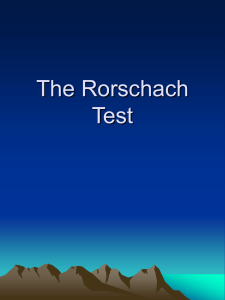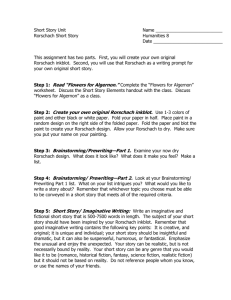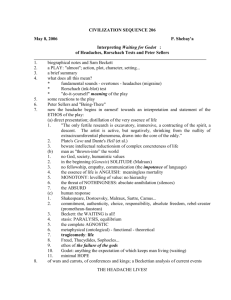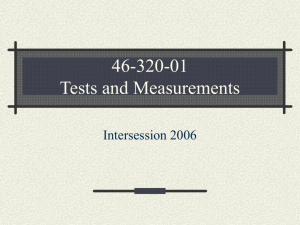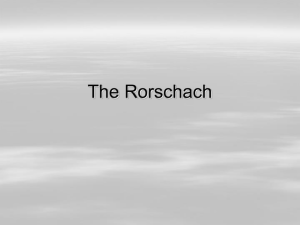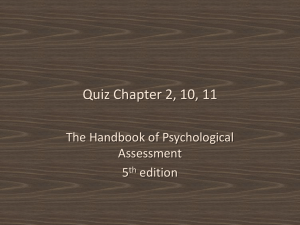The Significance of the Rorschach Pure Color Response
advertisement
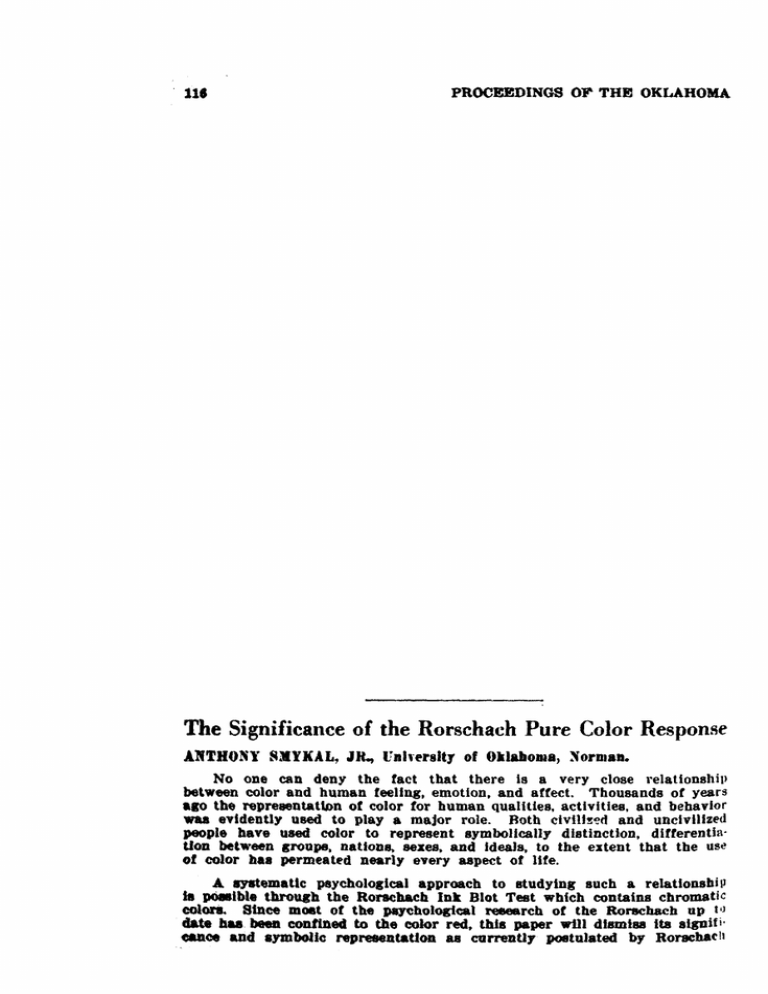
11.
PROCEEDINGS OF THE OKLAHOMA
The Significance of the Rorschach Pure Color Response
ANTHONY
~)(YKAL,
JR., UnlHorslty of OIdallom8, XorDI8D.
No ODe can deny the fact that there is a very close relationship
between color and human feeling, emotion, and affect. Thousands of years
&10 the representation ot color for human qualities, activities, and behavior
was evidently used to play a major role. Roth civnb:~d and uncivilized
people have used color to represent symbolically distinction, differentiation between groupe, nations. sexes. and Ideals. to the extent that the use
of color has permeated nearly every aspect of life.
A. l)'Stematlc psychological approach to stUdying such a relationshilJ
18 pOe8ible through the Rorschach Ink Blot Test which contains chromatic
colora. Since moat ot the payehologlcal reeearch ot the Rorachach up t
elate baa been contInecl to the color red. this paper will dismiss ita slgnifi'
cance and symbolic repreeentatlon &8 currently postulated by Rorschacll
l
)
l.~ADEMY
OJ' SCIENCE :FOR 1961
111
workers Ernest G. SChachtel and SoIls Kates, Schachtel (8) claims that
color reaction may, among other personality characteristics, be indicative
of passivity, This point of view is supported and taught by Kates at the
University of Oklahoma.
EFFECTS OF
Rp'..n
Red radiation has been shown to accelerate the development of certain
lower animals, increase hormonal and sexual activity, to Increase the
healing rate of wounds. According to Blrren (2) the color red represents an attraction to stimulus, and as such, provides an excellent environment for the creation of ideas. It Is broadly used In situations in
which the commanding of human attention Is desired, as in advertising,
decorative purposes for gala events, danger warnings, and In therapy to
bolster human moods and counteract melancholia, In everyday communication we speak of "being in the pink," or "getting red hot," or "I saw
red," indicating in some respect a state of emotional arousal or activation,
The lore of ancient medicine and the superstitions of modern Urnes
indicate this color's importance In healing human illnesses, In Ireland
and Russia, red flannel was a remedy for scadet fever, red thread was
thought necessary in the teething of English children, red overcame nightmares in Japan, and In Macedonia red yarn was tied on the bedroom door
after the birth of a child to bind evil (2),
In the field of psychology, the striking quality of red was demonstrated
by Katz (4). He drove a row of broad-headed natls equally far Into a
dark gray board and then pasted red and blue squares alternately on the
tops of the nails. He reports that the reds appeared Visually nearer than
the blues by approximately one-half to one centimeter, Ruesch and Finesinger (7) Investigating the frequency of responses to the various colors
in the Rorschach cards, found that feebleminded patients responded to red
more frequently than othel's. Ford (3), In her Rorschach investigation
of pre-school children, found generally that the color red received more
prefel'ence, attention, and free usage at this stage of development than at
any ether time In life.
The color red apparently has two outstanding attributes. It is the most
strIking, strong, attention-catchlng color, perhaps dangerous, but fascinating. Evidence of our own experiences of staring into fires, and the
enchantment it has for most Uvlng organisms, tend to fall in with this
Idea. The other attribute Is that it seems to have a primitive quality in that
earlier civilizations fostered ft, and that the feebleminded and the young
children prefer it by choice.
According to the Rorschach rationale, the associative perceptions of
the Rorschach ink blots reflect the Inner Ufe of an IndivIdual. The
rationale is based on the assumption that all perceptual processes involve
an automatic and unconscious (beneath the level of awareness) process of
recalllng and organizing engrams of ear11er form perceptions before any
formulation or interpretation of any sUmulus could be conceptualized, and
tbat the performance embodied in a Rorschach protocol is a valid sample of
reality behaviOl' of the perlon being tested, Rorschach and his followers
claim that a subject's prevailing mode of affective expression and responsiveness, control of impUlse, control of action, and extratenalve tendencies are revealed by the way the color Is perceived In the ink blots (6).
He claimed that subjects who are 8table emotionally, give few or no pure
color answers. Beck (1) states, "Pure C In Rorschach 18 representative of
an IndiVidual who Is given to ungovernable Impulses and rages amountlng
sometimes to momentary PIIYchotic episodes 1n which there is a sehllm
between affect and Intellect." According to Rapaport (5). pure color
reaponaea appear to come about when there 18 a "short circuiting" proceM
PROCEEDINGS OP .THE OKLAHOMA
or;a-.octatlou. Tbe ~.bort ciTC1JIUng" implies that affect b,.-pa88e8 the
ml_tlft ad judllDental upeets of reallt,.. This may be equated. to
4lanPtloD in· tbe conne of perceptual pr0ce88e8. because pUTe color
respon.. Tepraenta elther tbe extreme of impul8ive and wlld affectlvity
or aD abendonment of all control. A predominance of C in protocols is
tbougbt to renect patterns of behavior characterized by uninhibited chaotic
emottoJJal re.ponBe, expJOIiveneu, uncontrolled primitive emotion8, egocentric affectivity, Mgldlty, lack of spontaneity. and inadequate repres8ion.
Schachtel (8) haa developed a radical modification of the C rationale.
Ht. Invntlgatlolll suggest that the C response, although indicative of depth
of emotional res POD Ie, does not neceuart1y imply impulsivity or immediaten. . of responae to Btfmult only, but may gauge a depth of passivity and
conformity. He states that the peMlon giving a predominance of color
a.oclatlons to the Ink blot test may be paNive and the kind of a person
wbose activities are largely determined and provoked by imm£dlate en·
vlronmental stimull ratber tban by tbe spontaneity of his self. In Scbach·
tel'. word., "Such an individual 18 affeeted by bls environment and reacts
to it, il Influenced by it, adapts himself to it. and. tn more extreme cases,
merges 10 completely wJtb it a8 to all but lose his self." In tbis sense,
a pereon gives up hll personality and substance. submerges in the multitudt'
and. therefore, Is pa88fve. Certainly, Schachtel has made an extl'emelr
valuable contribution In Rorschach Interpretation of pure colm' response
In reference to passivity.
The following case history ot a psychosomatic paUent from the University Montal Hygiene Clinic. tends to substantiate the more recent thinking
ot Rorscbach workers concerning the rationale ot pure color response.
The patient presented herself to the out-patient department tn September 1961, at which time a cervical tumor was removed. Two days aUet·
returning borne she noticed an erythematous nodular swelling about 1 ~
centimeters In diameter. She bathed this lesion with salt water without
result. During the time trom tben until readmission on October 16, 19&1,
more leelon8 of the same type appeared on the thighs and legs. some of
them becoming confluent.
The patle~t bad no bl8tory of any allergies or skin rashes. A review
of ber health blstory indicated that she frequently had "sick" hl'adaches
In the frontal and temporal regions, and that these occurred when she
eqaaed In any unuaual activity or wben 8he had some traumatic experience, auch aa having ber lIOn Join the Navy, hearing that his sblp bad
been aunk, or when hearing that fighting had started in Korea. She also
had headache. and was sick In general when her cblldren got married.
although no organic basis could be related to ber Illness. During the
neuro-psychlatrlc examination tbe patient denied any psychiatric symptoms.
At the Mental Hygiene CUnic. the psycbiatric social worker obtained
the following Information trom the patient:
"Falnlly Background: Patient was born in a small community near
Clinton. ArkanlU. and lived in Arkanau untn ahe W88 about 20 years old.
wu one of the older children ot a large family. Tbe fatber was a
farmer and all the chUdren bad to work on the farm In order to make
• blare JITJq. The pannta lived to their tittles and botb died of Brlgbt's
S"
4Jaeue.
'~~l'IOnal
Hlltor,: Patient quit school when sbe was 16 because of lack
.,."'
t
eNet
....
belq
at bome. She lDa.rrled at 17, a boy about ker
. ' " ..... an they
She
two children by
husband
Dee4led
bepIl fa~t...
ba4
this
child was three moBtha old. Tbey bad moved
.... ~ at ha. lDeIateaee. altlloUSh· they had been dolna well In ArkaD8a&
. . . tfJd,
cb&Ilee to mab a crop ID Teus uad lost all of tIlelr
!. . .
.n,r __ ,. .tit. Patlent ClUIl8 to . . .all town tn Oklahoma
W'lao."
70Qnaer
.,...t.ot_.....
wheDthe
ACA.DEMY 01' SCIENCE FOR 11S1
119
lfhere a sister lived. and for the next two years did any kind of work abe
could get to support her children. After being a widow for two yean, Ihe
was remarried to· a man 20 years older than she. There is one child by
this marriage. a girl -now 25.
"Patient's only son has been in military service since World War II.
He has been overseas much of the Ume and patient wOl'rles about him.
Last summer he was home on leave and accidentally shot his foot and
has been h08pltaUzed since for orthopedic repair and plastic Burgery.
He is at present In a Navy hospital. There appears to be some ill feeUng
between patient and son's wite who ltves in 88me town as patient. However, patient attempts to cover this up,"
Following the social history taking, the patient was referred to the
psychologist tor psychological evaluation. Several tests were administered.
However, for the purpose of this study, only the Rorschach test results
will be taken up. The Rorschach protocol obtained on the patient is as
follows:
I.
37/136
3.
WF+ A
DF- Sex
DF+ Ad
4.
5.
DC Blood
DFC- An
1.
2.
II.
7/65
W
D
Dd
DDd
4/49
6.
7.
DC Blood
DM+ HP
C
FC-
CPo
IV.
15/83
V.
14/45
VI.
24/54
VII.
26/78
VIII.
14/60
8.
9.
F+ 73
A 33
P
4
0
S
18
M
III.
4
12
1
1
1
3
1
1
WF+ AP
FY-
1
WF+ AP
F+
F-
8
3
T/R 16.3
T/IR 39
Ap.' W!D(Dd)
Seq. Rigid
M/C 1/6
W/M 4/1
18
IX.
4/71
Ie. WFY- An
11. DdDF+ House
12.
(DF+ Hd)
14.
ne Blood
DF+ AP
15.
DPoC An
16.
DF- An
(DF- Ad)
(DF+ Ad)
13.
H
Hd
1
1
A
4
3
3
Ad
Blood
An
Sex
Hous"
4
1
1
18
X. 18/&5
17.
18.
R=18
In connection with the thesis of this paper it 18 to be noted that the
patient is bealcally endowed with an extratenslve type of personalfty, aa
hlAlicated by the ratio of movement to color, which ta 1/6. Her reepoD881
to Cards II, III, and VIII contained "blood" reepoD.le8, hence being ecore4
ae pure C. The oaly FC association given was on Card II, and that prove4
to be of interior quality 80 far . . accuracy of form perception is concel'lle4t
lUlCI wu etven a minu soori.g. The patieat dl8pla,ed Booe· of tile
behavioral charactertsUes tbat are ulRl&lly attributed. to people who ely.
Pve color (C) respouses to the Ink biota. However, the followlol' is en.
deae. of a pusiYe adj1Ultment:
118
PROCEEDINGS OF THE OKLAlWMA
. 1. The IOelal hlatol'7 reveals that after the death of her first hUBband.
Ih. retunaed to a lJDall to:wn and coneclenUously attempted to support
her chUd~n, married a man nearly tWice her age, and expressed a determination to provide her children with a happy, comfortable home, no
matter wbat the aacrlftce.
2. In the tetltlng situation the patient displayed characteristics of a
complaint, sUbmleslve individual who went out of ber way to display cooperation and wmngness to do anything requested of her. At that time she
reveaJed that the content of her worries concerned her only Bon who was
ahot In the leg, her husband's health, and her daughter-In·law's trying marital
circumstances. She avoided making complaints about her own condition,
never questioned the objectives of the test, nor expressed any annoyance,
even when periods of frustration were Quite evident.
3. Attending psychiatrist's notation on patient-"This patient was
contacted very briefly during the course ot a psychosomatic conference,
and It was discovered that her chief complaints were painful, swollen, red
nodules scattered over both legs, which had arisen approximately one
week before her hospitalization. The impression was that this \latient has
euentlally adjusted to life by absorbing the shocks and blows which have
occurred and, In fact, the total lack of external ized aggression seems
strikingly apparent, and It was felt that her adjustment was primarily
one of masochistic qualities. The diagnosis which she carried regarding
the nodules on ~er legs was erythema nodosum."
.
4. A perusal of the nurses' notes covering this patient's stay at the
hospital reveals the unusual absence of any complaints, depression, irritability, or uncooperaUveness. For example, on approximately the 18th
day of her confinement the followhig note was registered on her chart:
"Up at 8:00 a.m. ToJ)et care and bath performed. Up and about, very
cheerful. Said she had no bowl movement for six days, and that she bled
from the rectum while straining on the stool. Was given enema with
good results. Feels very well and is cheerful." Another recording indicated,
"ResUng, no complaints. Appears to be having chills."
SUMMARY OF PSYCtlOI.OOJ('.\J.
TI!:8TI~G
This Is the kind of person who apparently maximizes aspects of life
beyond their proportion, without being analytical or cl'iUcal of their validity.
Affectlvely she appears to have a temperament of an Individual conditioned
to be oversens1Uve and oversympatheUc to her environment. That Is, sha
18 prone to respond to affect Instantly and with intensity, to the extent
that she may feel overtly upset or disturbed from sympathy for persons or
events not closely related to her. There appears to be a tendency to internaUle and introject anxiety In order to avoid censure from the environment,
~ much the 88me manner as a masochistic Individual. This may constitute
what appears to be a characteristic of passivity. This inference to passivity
18 substantiated by Information contained In the social history, her reaction
to the testing 8ituatlon, her contacts with the PSYChiatrist, and, finally,
by close observation of her during her 3O-day confinement at the University
Hospital.
In brief, thla paper attempts to bring together various concepts and
Botlou of the color red, its slgnlfteance and role In human interaction, and
Ita meaning as It Ie related to the psychological framework of the Rorschach
Ink· Blot Teet. .The point of view originated by Sehachtel and taught by
Kate..· that pure color Rorschaeh reaponBe8 may symbolically represent
puaSY. eharacte....Uea, .... dtscu888d. A ease hl8tory, medical opinion,
'aIlcl a Ronchach protocol with a predominance of C responses of a patient
nfferInc .from a peychoeomaUc DIn.. were presented to further BUb-.tta... this aew raUOD&1e.
ACADEMY OF SCIENCE FOR 1961
121
BIBLIOGRAPHY
1. BECK, SAMUEL. 1949. Rorschach's Test II. New York: Grune and
Stratton.
2. BIBBEN, FABER. 1950. Color psychology and color therapy. New York:
McGraw Bill Book Co.• Inc.
3. FORD, MARY. 1946. The Rorschach test with young children. Min·
neapolis, Minn.: The University of Minnesota Press.
4. KATZ, DAVID. 1935. The world of color. London: Keagan, Paul.
Trench and Trubner.
6. RAPAPORT, D. 1946. Diagnostic pshchologlcal testing, Volume II.
Year Book Publishers.
6. RORSCIIACH, H ..:RYAN. 1942. Psychodiagnostics. A diagnostic test based
on perception. English edition by Paul Lemkau and Bernard Kroneuberg.
Berne, Switzerland: Hans Huber.
7. Rl!E8CH, JUBGEN and J. F. FI~":SI~GER. 1941. The relation of the
Rorschach color responses to the use of color In drawings. Psychosom.
Med. :1: 370-388.
8. SCJlACHT..:L, F. G. 1943. On color and affect. Psy.chlatl'y Ii: 393·409.
